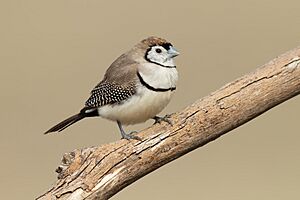Double-barred finch facts for kids
Quick facts for kids Double-barred finch |
|
|---|---|
 |
|
| Glen Davis, New South Wales, Australia | |
| Conservation status | |
| Scientific classification | |
| Subspecies | |
|
See text |
|
| Synonyms | |
|
Taeniopygia bichenovii (Vigors & Horsfield, 1827) |
The double-barred finch (Stizoptera bichenovii) is a small, pretty bird. It lives in northern and eastern Australia. You can find it in dry grasslands and areas with shrubs. People sometimes call it Bicheno's finch or the owl finch. It's called the owl finch because of the dark feathers around its face. These feathers look a bit like an owl's eyes. This bird is the only one in its special group, called Stizoptera.
Contents
About the Double-Barred Finch
How It Got Its Name
Scientists officially described the double-barred finch in 1827. Two naturalists, Nicholas Aylward Vigors and Thomas Horsfield, gave it its first scientific name. They found these birds in Queensland, Australia.
The name Stizoptera comes from old Greek words. Stizō means "to tattoo," and pteron means "wing." This might be because of the patterns on the bird's wings. The second part of its name, bichenovii, honors James Ebenezer Bicheno. He was an important person in Van Diemen's Land (now Tasmania) a long time ago.
Different Types of Double-Barred Finches
There are two main types, or subspecies, of the double-barred finch:
- S. b. annulosa – This type lives in northern Western Australia and the Northern Territory.
- S. b. bichenovii – This type is found from northern Queensland down to southeast New South Wales.
What Does It Look Like?
The double-barred finch is a small bird, about 10 to 11 centimeters long. That's about the length of your hand! It has a white face with a black border. Its back and throat are brown. Its belly is white.
A cool thing about this bird is the two black lines, or "bars." One black line is around its white face. Another black line separates its brown throat from its white belly. Its wings have pretty brown and white patterns. Both male and female birds look very similar. Young birds are a bit duller and browner in color. The S. b. annulosa type has a black bottom (rump), while the S. b. bichenovii type has a white one.
How It Behaves
Double-barred finches love to eat seeds. They are also very social birds. This means they like to live in groups.
They build their nests in tall grass, bushes, or low trees. A female finch usually lays four to six eggs at a time. When they call out, it sounds like a soft tet or a louder peew. Their song is a gentle, fluting sound. It's a bit like the song of a zebra finch.
Images for kids





